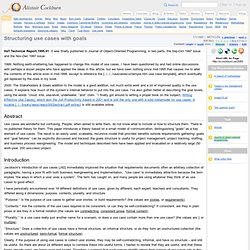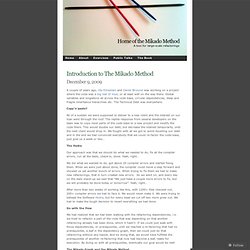

Structuring use cases with goals. HaT.Technical Report.1995.01.

It was finally published in Journal of Object-Oriented Programming, in two parts, the Sep-Oct 1997 issue and the Nov-Dec 1997 issue. 1999: Nothing earth-shattering has happened to change this model of use cases. I have been questioned by and had online discussions with perhaps a dozen people who have applied the ideas in this article, but we have seen nothing since mid-1995 that causes me to alter the contents of this article even in mid-1998, except to reference the [../../..
/usecases/uctempla.htm use case template], which eventually got replaced by the ones in my book. Why I still use use cases. XP pretty much banned use cases, replacing them with the similar sounding “user stories” (see A user story is to a use case as a gazelle is to a gazebo (discussion: Re: A user story is to a use case as a gazelle is to a gazebo)}, and as a result agile zealots have been happy to dump use cases in the trash (along with their project managers, estimates, plans, and architectures).

Scrum did similar, using the “product backlog” instead of user stories. Yet as I go around projects, I keep running across organizations suffering from three particular, real, painful, and expensive problems: User stories and backlog items don’t give the designers a context to work from – when is the user doing this, and what is the context of their operation, what is their larger goal at this moment? Use cases are, indeed, heavier and more difficult than either user stories or backlog items, but they bring value for that extra weight. As not-Einstein said: “Make things as simple as possible, but no simpler.”
S. Use cases vs User stories in Agile/Scrum development. TL;DR – User stories aren’t use cases.

Freckle: Friendly Online Time Tracking Software — Your Team will love it! Spikes in Scrum: The Exception, not the Rule. In Agile software development, the architecture evolves to meet the needs of the Product Backlog Items (PBI’s) forecasted in the given Sprint.

It’s lean. Unlike a bridge or a skyscraper, developing business software does not necessarily require all of the architecture defined upfront. Spikes are an invention of Extreme Programming (XP), are a special type of story that is used to drive out risk and uncertainty in a user story or other project facet. It may be necessary to Spike on the best persistence option, but the implementation of it should be wrapped into a PBI. Spikes, by definition, have a maximum time-box size of one sprint.
The Agile Onion – 4 Fundamental Aspects of the Agile Universe » Agile Trail. Your Development Tools. Static/ScrumBoardCheatSheet.pdf. How to start unit testing or TDD. ScrumAndXpFromTheTrenchesonline07-31.pdf. 7 Steps to Build a Kanban Board for a Scrum Team’s Impediments » Agile Trail. A Kanban board for impediments and actions According to the Scrum Guide, “Daily Scrums … identify and remove impediments to development …“.

They also advise that this is a service for the Development Team offered by the Scrum Master. Often an impediment backlog is used for this purpose. I’d advise the Scrum Master to use a Kanban board for handling the Development Team’s impediments. Most of the Scrum teams I’ve seen over time use impediment backlogs. Lack of transparence: Only the Scrum Master has access to that list, and even to him that list is not visible all the time.Lack of participation: The Development Team can’t participate in the almost secret list.
With the last two Scrum Teams I worked with, we came to the following solution: an action board, which is in fact a Kanban board for actions. From Excel to flip chart Put each impediment item on one line on the flip chart. That’s better, because it’s visible and therefore transparent for everyone involved. Use name tags That’s it. The Mikado Method. Introduction to The Mikado Method. A couple of years ago, Ola Ellnestam and Daniel Brolund was working on a project where the code was a big ball of mud, or at least well on the way there.

Global variables and singletons all across the code base, circular dependencies, deep and fragile inheritance hierarchies etc. The Technical Debt was everywhere. Copy’n’paste? All of a sudden we were supposed to deliver to a new client and the interest on our loan went through the roof. The reptile response from several developers on the team was to copy most parts of the code base to a new project and modify the code there. The Hydra Our approach was that we should do what we needed to do, fix all the compiler errors, run all the tests, check-in, done. We did what we wanted to do, got about 20 compiler errors and started fixing them.
After more than two weeks of working like this, with 1200+ files checked out, 200+ compiler errors we had to face it.